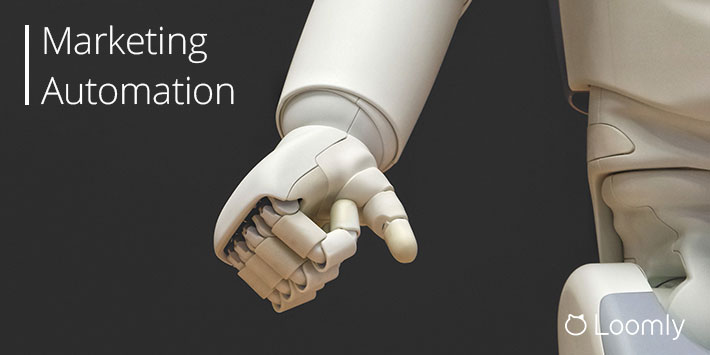Marketing Automation FAQ
Marketing automation is used across various channels, including email, social media, SMS, and digital ads, to automate repetitive tasks, streamline marketing workflows, and measure marketing campaign outcomes.
But who actually needs marketing automation? And how do you implement a successful marketing automation strategy?
In this Marketing Automation FAQ, the Loomly Team addresses all of your burning questions.
TABLE OF CONTENTS
- What is marketing automation?
- What is marketing automation used for?
- What are the benefits of marketing automation?
- Which marketing automation mistakes should you avoid?
- Who needs marketing automation?
- How to implement a successful marketing automation strategy?
- How much does marketing automation cost?
- How can I learn marketing automation?
- What are the best automation marketing tools?
What is marketing automation?
Marketing automation uses software to automatically complete marketing tasks – not only to increase the efficiency of the marketing team but also provide a more personalized experience to their customers.
For instance, you can automate specific repetitive tasks, such as:
Marketing automation tools can still be customized to your requirements and personalized for your customers, for example, with their name or recent product views.
You’ve probably experienced personalized marketing automation when you left items in your online shopping cart.
For example, Chubbies automatically sends a pre-written cart abandonment email to any customer who leaves their website with an item in their cart to encourage them to complete their purchase.
In short: Marketing automation allows you to rapidly scale your efforts across multiple channels and deliver a consistent experience regardless of customers’ differing interests or needs.
What is marketing automation used for?
There are three basic categories of marketing automation:
- Marketing intelligence uses tracking codes to monitor customers’ online behaviors. For example, Amazon tracks your behavior and enhances your shopping experience by recommending additional products to you, sending reminders, alerting you to price changes and more.
- Business development focuses on moving potential customers from the top of the sales funnel (initial awareness) to the bottom of the funnel (ready to buy). It uses various channels, such as email, social media, SEO, and content marketing, to segment and nurture leads based on interests, score or qualify leads based on fit and intent, and then attempt to close based on behavioral and attitudinal factors.
- Workflow automation refers to internal processes like budgeting, the marketing calendar, digital asset management, and everything else that large enterprises need to run sizable, complex marketing departments efficiently.
What are the benefits of marketing automation?
The benefits of marketing automation include:
- Increased marketing efficiency by automating time-consuming, manual tasks.
- Enhanced ability to generate and identify more sales-qualified leads by combining multiple criteria with a lead scoring system.
- Detailed view of prospect behavior by integrating multiple channels and devices.
- Better alignment of sales and marketing goals by working cooperatively to set scoring parameters and define qualified leads.
- Improved lead conversion and ROI. Forrester found that B2B marketers who implement marketing automation experience a 10% increase in their sales pipeline contribution.
Which marketing automation mistakes should you avoid?
Here are six marketing automation mistakes to avoid:
1. Starting without a plan
Marketing automation will likely fail if you don’t have a strategy in place.
A survey by Three Deep Marketing found that 58% of marketers felt they were having trouble finding success with automation tools due to a lack of an effective strategy.
2. Blasting irrelevant content
It’s easy to create and schedule campaigns quickly with marketing automation tools. But it’s also easy to go overboard and blast too many emails or social media posts to audiences that aren’t relevant.
3. Failing to integrate technology
Marketing automation has to integrate with your other tools and databases to be successful. For instance, according to ResearchCorp, 89% of users that have deployed marketing automation systems have integrated them with their CRM systems.
4. Setting it and forgetting it
While marketing automation certainly saves time by automating manual tasks, you can’t simply “set it and forget it” – someone still needs to manage and monitor campaigns.
Make sure you check automated campaigns and monitor their performance to catch any errors or unwanted outcomes. For example, a trigger not working correctly or a drop in engagement resulting from your automation process.
5. Not testing or optimizing
Testing is a critical part of marketing automation, enabling you to learn more about your audience and predict whether or not a strategy or campaign will succeed. Based on results, you can make changes to optimize campaigns.
For example, you could conduct A/B testing of your email marketing automation by comparing elements such as the subject line, CTA, or sender address. (Ensure you only test one variable at a time to find out why something is working).
6. Fixating on the wrong metrics
When reviewing the performance of an automated campaign, it’s easy to get excited by a high-performing metric and ignore other significant numbers.
For example, it’s good to see a high email open rate, but this metric doesn’t necessarily mean a campaign performs well. You also need to check the click-through rate to measure a campaign’s success.
Who needs marketing automation?
You know you need marketing automation when…
- you spend more time building and updating standard operating procedures for different tools than you actually use the tools
- you don’t nurture leads
- you send each email campaign, response, and blog post manually
- you can’t connect your activities to trackable metrics
- your website doesn’t generate enough leads and sales
- your website isn’t nurturing visitors
- you would like to increase your online sales
- you would like to stop outbound sales
- you would like to prevent cold call rejections
- your sales team needs more qualified leads
- your sales team would like to understand their prospects better
- your company would like predictable monthly leads
- you would like to maximize your email list
- you would like to grow your email list
- you think social media can help your company
- you are not sure your content marketing is working
How to implement a successful marketing automation strategy?
Implementing a marketing automation strategy isn’t easy. But by asking the right questions about whom you want to reach and what you want to provide before, during, and after conversion, you can create a winning strategy for your brand.
Step 1: Plan
- How is marketing automation best used?
- What tasks are most realistic to automate?
- What tasks require a human touch?
Step 2: Implement
- Attracting the attention of potential customers or leads
- Example: Leverage automation to provide a customized onboarding experience
- Converting leads into customers
- Example: Bring shoppers with abandoned carts back to finish their purchase
- Adding value to your customers
- Example: Make use of your existing content
Step 3: Measure
- Evaluate automation effectiveness
- Ask yourself questions while reviewing the results
- What’s working well?
- Are messages being delivered at the right time?
- Are leads or customers engaging with your messages?
- What’s not working?
Step 4: Optimize
- Run A/B testing to see if one version outperforms the other.
- Example: split-test the headlines in your email marketing messages:
- Version A: sent with an emotional headline
- Version B: sent with a statistical headline
- Example: split-test the headlines in your email marketing messages:
How much does marketing automation cost?
Marketing automation systems vary hugely in price, but you can break their pricing down into these core components:
- Contacts: How many contacts (leads, customers, etc.) do you need to be able to store?
- Features: Does the system have the capability and functionality to do what you need?
- Users: How many people in your business will need to use it?
- Support: How much help do you need setting up, running, and maintaining your marketing automation?
How can I learn marketing automation?
Marketing automation comes at the intersection of Sales, Marketing, and Technology. Here’s to how to learn marketing automation:
- Know salespeople well enough to attain alignment. You should understand what drives salespeople. For example:
- Salespeople are motivated by commissions on revenue.
- Salespeople will find leads from anywhere if they do not get them from marketing.
- Salespeople will do whatever they can to win business.
- Know marketing. You should be familiar with these disciplines:
- Inbound marketing
- Content marketing
- Outbound marketing
- Permission marketing
- Direct marketing/Demand generation
- Measuring success or failure
- Know technology systems. You should be familiar with:
- Database concepts
- Flow charts
- Marketing automation platforms
- CRMs
- The principles of data cleanliness
- Understand basic logic. You must know Boolean logic well enough to target audiences effectively. For example:
- AND/ALL: both filters are true, so the lead(s) returned must have both true.
- OR/ANY: either filter can be true, so the lead returned can have both or just one true.
- NOT: the lead must not have these criteria true.
- Play to learn. You must be prepared to ask questions and test ideas. For example:
- Can I set up a workflow that sends five emails every three days?
- Can I get it to only deliver on Monday through Friday at 7:00 A.M.?
- Help others. You can help others grow in marketing automation by:
- Participating in marketing communities.
- Writing a blog about things you can do with automation.
- Training your colleagues to do their jobs faster with new skills.
- Writing documentation for your audience.
- Treat your audience as you’d like to be treated. You must always:
- Provide something helpful to your audience.
- Test your automated campaigns before sending them.
- Honor unsubscribes.
What are the best automation marketing tools?
Marketing automation tools usually come with advanced email marketing features, such as A/B testing, spam filter testing, scheduling, and segmentation, plus extensive analytics features to measure the success of a campaign across segments and channels.
Here’s our Top 5 (in alphabetical order):
-
- ActiveCampaign – used by brands of all sizes for its comprehensive segmentation and personalization across social, email, messaging, chat, and text.
- Drip – used by marketers to build stronger and more profitable relationships with their customers.
- Intercom – includes everything you need to build better customer relationships through personalized, messenger-based experiences across the customer journey – without overwhelming your team.
- Marketo – used by marketing and sales teams to coordinate interactions with customers that are both personalized and measurable.
- Omnisend – helps ecommerce brands increase their sales on autopilot, converting their customers with custom-made, highly relevant emails and texts.

Manage all your social media accounts in one place.
Craft, schedule, & auto-post content to all your social channels, then track analytics and manage interactions from a single, easy-to-use dashboard.
In a Nutshell
Marketing automation uses software not only to increase the efficiency of your marketing team but also provide a more personalized experience for your customers.
You can implement a marketing automation strategy by asking the right questions about which marketing processes you can automate, whom you want to reach, and what you want to provide before, during, and after conversion.



